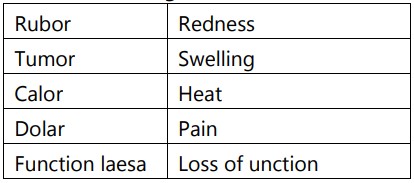Table of Contents
What is Inflammation
Inflammation is a critical homeostatic process that is activated by cellular injury regardless of the mechanism of that injury. Inflammation is essentially local in nature, although cellular mediators released during inflammation may initiate systemic responses as well. Systemic inflammatory response syndrome is the most extreme form of inflammatory response and may be life-threatening in critically ill patients. This syndrome nearly always occurs in the setting of systemic infection and is termed sepsis.
It can also be defined as “the local response of living mammalian tissues to injury due to any agent”. It is a body defense reaction in order to eliminate or limit the spread of injurious agents, followed by removal of the necrosed cells and tissues. Inflammatory processes are defensive or adaptive by design; however, they may contribute to distressing clinical manifestations of the disease. At the same time, they are helping to eradicate it. Inflammation is the body’s attempt at self-protection; the aim being to remove harmful stimuli, including damaged cells, irritants, or pathogens, and begin the healing process.
Inflammation does not mean infection, even when an infection causes inflammation. Infection is caused by a bacterium, virus, or fungus, while inflammation is the body’s response to it. Any injury, including an invasion by micro-organisms, causes inflammation in the affected area. Inflammation, a complex reaction, results from many different conditions. The damaged tissue releases substances that cause inflammation and that direct the immune system to do the following:
- Attack and kill any invaders.
- Dispose off dead and damaged tissue.
- Begin the process of repair.
Etiology of Inflammation
The agents causing inflammation may be as follows:
Physical agents: Heat, cold, radiation, and mechanical trauma.
Chemical agents: Organic and inorganic poisons.
Infective agents: bacteria, viruses, and their toxins.
Immunological agents: Cell-mediated and antigen-antibody reactions.
Cardinal signs of inflammation
The Roman writer Celsus in 1st Century A.D. named the famous four cardinal signs of inflammation:

Rubor: Latin term for “redness”. This is because the capillaries are filled up with more blood than usual.
Tumor: a Latin term for “swelling”. Caused by an accumulation of fluid.
Calor: Latin term for “heat”. As with the reason for the redness, more blood in the affected area makes it feel hot to the touch.
Dolor: Latin term for “pain”. The inflamed area is likely to be painful, especially when touched. Chemicals that stimulate nerve endings are released, making the area much more sensitive.
To these, the fifth sign function laesa (loss of function) was later added by Virchow.
Also read: Morphology of cell injury adaptive changes
